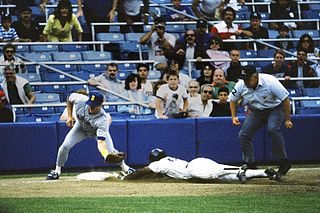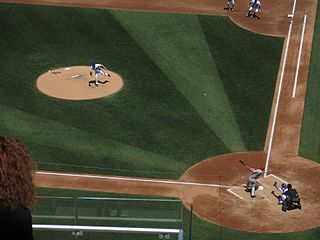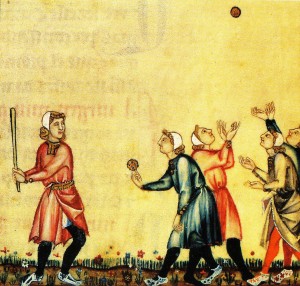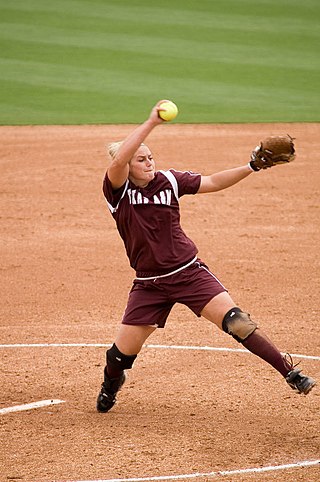
In baseball and softball, a lead or lead off is the short distance that a player stands away from their current base. [1]

In baseball and softball, a lead or lead off is the short distance that a player stands away from their current base. [1]
In baseball, to lead off, or to take a lead, refers to the position a baserunner takes just prior to a pitch, a short distance away from the base the player occupies. [2] A "lead" can also refer to that distance. [2] A typical lead is six to ten feet (two to three meters) from the base. If the lead is too large, the runner risks being picked off. If the lead is too small, the runner has a disadvantage in reaching the next base, whether in a stolen base attempt or in connection with the next batted ball.

In baseball, a stolen base occurs when a runner advances to a base unaided by other actions and the official scorer rules that the advance should be credited to the action of the runner. The umpires determine whether the runner is safe or out at the next base, but the official scorer rules on the question of credit or blame for the advance under Rule 10 of the MLB's Official Rules.

In baseball, a player is credited with a plate appearance each time he completes a turn batting. Under Rule 5.04(c) of the Official Baseball Rules, a player completes a turn batting when he is put out or becomes a runner. This happens when he strikes out or is declared out before reaching first base; or when he reaches first base safely or is awarded first base ; or when he hits a fair ball which causes a preceding runner to be put out for the third out before he himself is put out or reaches first base safely. A very similar baseball statistic, at bats, counts a subset of plate appearances that end under certain circumstances.

Baseball is a bat-and-ball sport played between two teams of nine players each, taking turns batting and fielding. The game occurs over the course of several plays, with each play generally beginning when a player on the fielding team, called the pitcher, throws a ball that a player on the batting team, called the batter, tries to hit with a bat. The objective of the offensive team is to hit the ball into the field of play, away from the other team's players, allowing its players to run the bases, having them advance counter-clockwise around four bases to score what are called "runs". The objective of the defensive team is to prevent batters from becoming runners, and to prevent runners' advance around the bases. A run is scored when a runner legally advances around the bases in order and touches home plate.

Softball is a game similar to baseball, and it is played with a larger ball on a smaller field and with only underhand pitches permitted. Softball is played competitively at club levels, the college level, and the professional level. The game was first created in 1887 in Chicago by George Hancock.
This is an alphabetical list of common English-language idioms based on baseball, excluding the extended metaphor referring to sex, and including illustrative examples for each entry. Particularly American English has been enriched by expressions derived from the game of baseball.
See also the Glossary of baseball terms for the jargon of the game itself, as used by participants, fans, reporters, announcers, and analysts of the game.

An outfielder is a person playing in one of the three defensive positions in baseball or softball, farthest from the batter. These defenders are the left fielder, the center fielder, and the right fielder. As an outfielder, their duty is to catch fly balls and ground balls then to return them to the infield for the out or before the runner advances, if there are any runners on the bases. As an outfielder, they normally play behind the six players located in the field. By convention, each of the nine defensive positions in baseball is numbered. The outfield positions are 7, 8 and 9. These numbers are shorthand designations useful in baseball scorekeeping and are not necessarily the same as the squad numbers worn on player uniforms.

In baseball, an intentional base on balls, usually referred to as an intentional walk and denoted in baseball scorekeeping by IBB, is a walk issued to a batter by a pitcher with the intent of removing the batter's opportunity to swing at the pitched ball. A pitch that is intentionally thrown far outside the strike zone for this purpose is referred to as an intentional ball.

A first baseman, abbreviated 1B, is the player on a baseball or softball team who fields the area nearest first base, the first of four bases a baserunner must touch in succession to score a run. The first baseman is responsible for the majority of plays made at that base. In the numbering system used to record defensive plays, the first baseman is assigned the number 3.

Extra innings is the extension of a baseball or softball game in order to break a tie.
The outfield, in cricket, baseball and softball is the area of the field of play further from the batsman or batter than the infield. In association football, the outfield players are positioned outside the goal area.

Throughout the history of baseball, the rules have frequently changed as the game continues to evolve. A few common rules most professional leagues have in common is that four balls is a base on balls, three strikes is a strikeout, and three outs end a half-inning.

A baseball field, also called a ball field or baseball diamond, is the field upon which the game of baseball is played. The term can also be used as a metonym for a baseball park. The term sandlot is sometimes used, although this usually refers to less organized venues for activities like sandlot ball.
Baseball and cricket are the best-known members of a family of related bat-and-ball games. Both have fields that are 400 feet (120 m) or more in diameter between their furthest endpoints, offensive players who can hit a thrown/"bowled" ball out of the field and run between safe areas to score runs (points) at the risk of being gotten out, and have a major game format lasting about 3 hours.

Pesäpallo is a fast-moving bat-and-ball sport that is often referred to as the national sport of Finland and has some presence in other countries including Germany, Sweden, Switzerland, Australia, and Canada's northern Ontario. It is similar to brännboll, rounders, and lapta, as well as baseball.

Andrew Pafko was an American professional baseball player. He played in Major League Baseball (MLB) for the Chicago Cubs (1943–51), Brooklyn Dodgers (1951–52), and Milwaukee Braves (1953–59). He batted and threw right-handed and played center field.

Bat-and-ball games are field games played by two opposing teams. Action starts when the defending team throws a ball at a dedicated player of the attacking team, who tries to hit it with a bat and run between various safe areas in the field to score runs (points). The defending team can use the ball in various ways against the attacking team's players to force them off the field when they are not in safe zones, and thus prevent them from further scoring. The best known modern bat-and-ball games are cricket and baseball, with common roots in the 18th-century games played in England.

Fastpitch softball, or simply fastpitch, is a form of softball played by both women and men. While the teams are most often segregated by sex, coed fast-pitch leagues also exist. Considered the most competitive form of softball, fastpitch is the format played at the Olympic Games. Softball was on the International Olympic Committee (IOC) program in 1996, 2000, 2004, 2008, and 2020. It will not be a part of the 2024 Summer Olympic Games in Paris.
This is an alphabetical list of selected unofficial and specialized terms, phrases, and other jargon used in baseball, along with their definitions, including illustrative examples for many entries.

Baseball5 (B5) is an internationally played safe haven game with many of the same rules as baseball and softball, which is governed alongside those sports by the World Baseball Softball Confederation (WBSC).

Baseball is a bat-and-ball sport that has many recreational variants. The major sport most related to baseball is the Olympic discipline of softball, with the two sports being administered internationally alongside Baseball5 by the World Baseball Softball Confederation.